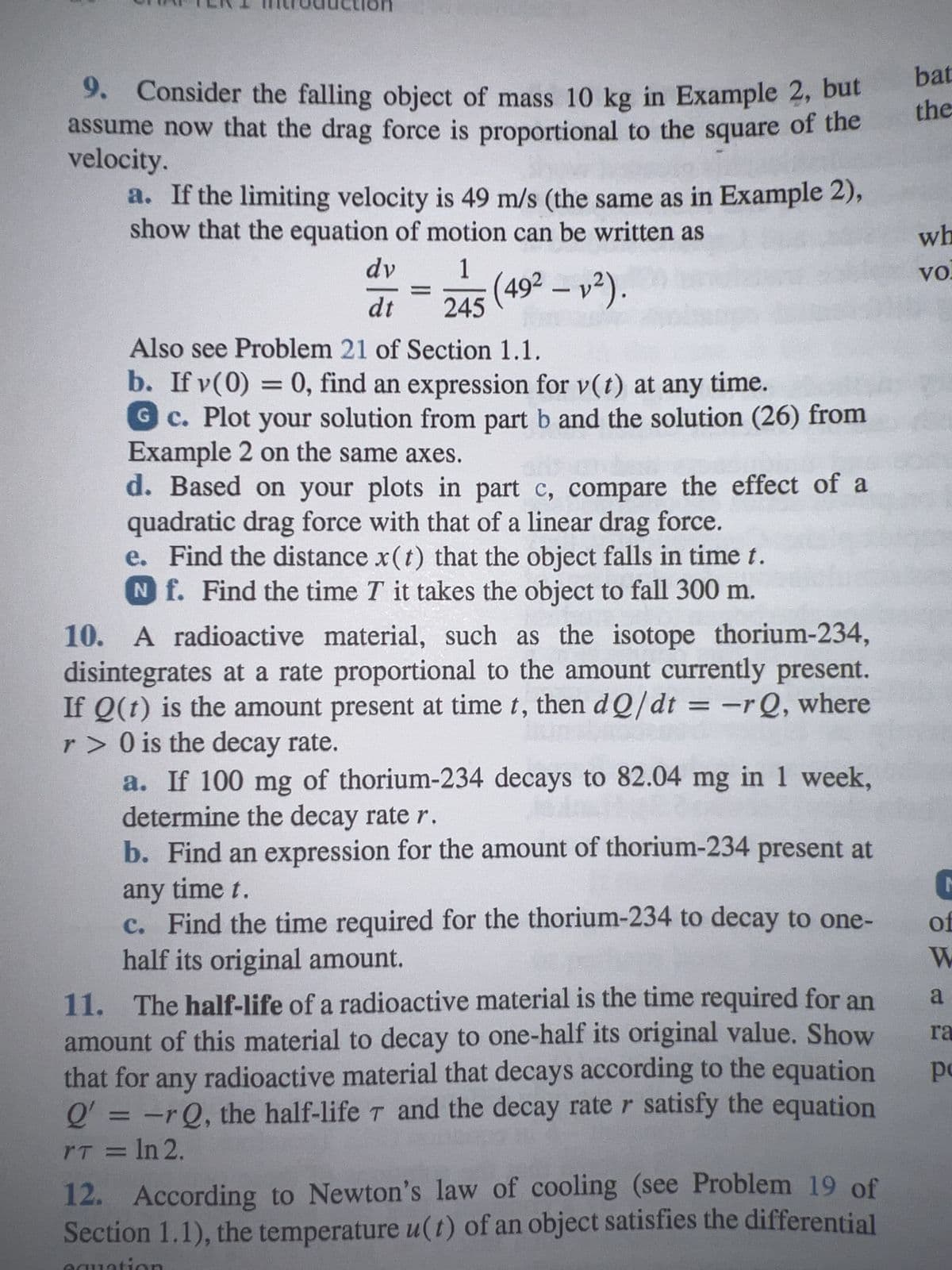9. Consider the falling object of mass 10 kg in Example 2, but assume now that the drag force is proportional to the square of the velocity. a. If the limiting velocity is 49 m/s (the same as in Example 2), show that the equation of motion can be written as dv dt 1 1 245 (49² - 1²). Also see Problem 21 of Section 1.1. b. If v(0) = 0, find an expression for v(t) at any time. G c. Plot your solution from part b and the solution (26) from Example 2 on the same axes. d. Based on your plots in part c, compare the effect of a quadratic drag force with that of a linear drag force. e. Find the distance x(t) that the object falls in time t. N f. Find the time T it takes the object to fall 300 m.
9. Consider the falling object of mass 10 kg in Example 2, but assume now that the drag force is proportional to the square of the velocity. a. If the limiting velocity is 49 m/s (the same as in Example 2), show that the equation of motion can be written as dv dt 1 1 245 (49² - 1²). Also see Problem 21 of Section 1.1. b. If v(0) = 0, find an expression for v(t) at any time. G c. Plot your solution from part b and the solution (26) from Example 2 on the same axes. d. Based on your plots in part c, compare the effect of a quadratic drag force with that of a linear drag force. e. Find the distance x(t) that the object falls in time t. N f. Find the time T it takes the object to fall 300 m.
University Physics Volume 1
18th Edition
ISBN:9781938168277
Author:William Moebs, Samuel J. Ling, Jeff Sanny
Publisher:William Moebs, Samuel J. Ling, Jeff Sanny
Chapter13: Gravitation
Section: Chapter Questions
Problem 59AP: A neutron star is a cold, collapsed star with nuclear density. A particular neutron star has a mass...
Related questions
Question
9 pl

Transcribed Image Text:on
9. Consider the falling object of mass 10 kg in Example 2, but
assume now that the drag force is proportional to the square of the
velocity.
a. If the limiting velocity is 49 m/s (the same as in Example 2),
show that the equation of motion can be written as
dv
dt
=
1
245 (492 - 1²).
Also see Problem 21 of Section 1.1.
b. If v(0) = 0, find an expression for v(t) at any time.
G c. Plot your solution from part b and the solution (26) from
Example 2 on the same axes.
d. Based on your plots in part c, compare the effect of a
quadratic drag force with that of a linear drag force.
e. Find the distance x(t) that the object falls in time t.
Nf. Find the time T it takes the object to fall 300 m.
10. A radioactive material, such as the isotope thorium-234,
disintegrates at a rate proportional to the amount currently present.
If Q(t) is the amount present at time t, then dQ/dt = -rQ, where
r> 0 is the decay rate.
a. If 100 mg of thorium-234 decays to 82.04 mg in 1 week,
determine the decay rate r.
b. Find an expression for the amount of thorium-234 present at
any time t.
c. Find the time required for the thorium-234 to decay to one-
half its original amount.
11. The half-life of a radioactive material is the time required for an
amount of this material to decay to one-half its original value. Show
that for any radioactive material that decays according to the equation
Q' = -rQ, the half-life 7 and the decay rate r satisfy the equation
rT = ln 2.
12. According to Newton's law of cooling (see Problem 19 of
Section 1.1), the temperature u(t) of an object satisfies the differential
bat
the
wh
vo
C
of
W
a
ra
po
Expert Solution
This question has been solved!
Explore an expertly crafted, step-by-step solution for a thorough understanding of key concepts.
This is a popular solution!
Trending now
This is a popular solution!
Step by step
Solved in 4 steps with 3 images

Knowledge Booster
Learn more about
Need a deep-dive on the concept behind this application? Look no further. Learn more about this topic, physics and related others by exploring similar questions and additional content below.Recommended textbooks for you

University Physics Volume 1
Physics
ISBN:
9781938168277
Author:
William Moebs, Samuel J. Ling, Jeff Sanny
Publisher:
OpenStax - Rice University

Classical Dynamics of Particles and Systems
Physics
ISBN:
9780534408961
Author:
Stephen T. Thornton, Jerry B. Marion
Publisher:
Cengage Learning

Physics for Scientists and Engineers: Foundations…
Physics
ISBN:
9781133939146
Author:
Katz, Debora M.
Publisher:
Cengage Learning

University Physics Volume 1
Physics
ISBN:
9781938168277
Author:
William Moebs, Samuel J. Ling, Jeff Sanny
Publisher:
OpenStax - Rice University

Classical Dynamics of Particles and Systems
Physics
ISBN:
9780534408961
Author:
Stephen T. Thornton, Jerry B. Marion
Publisher:
Cengage Learning

Physics for Scientists and Engineers: Foundations…
Physics
ISBN:
9781133939146
Author:
Katz, Debora M.
Publisher:
Cengage Learning